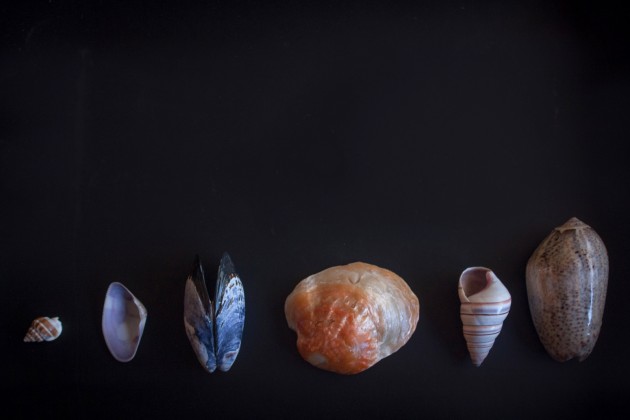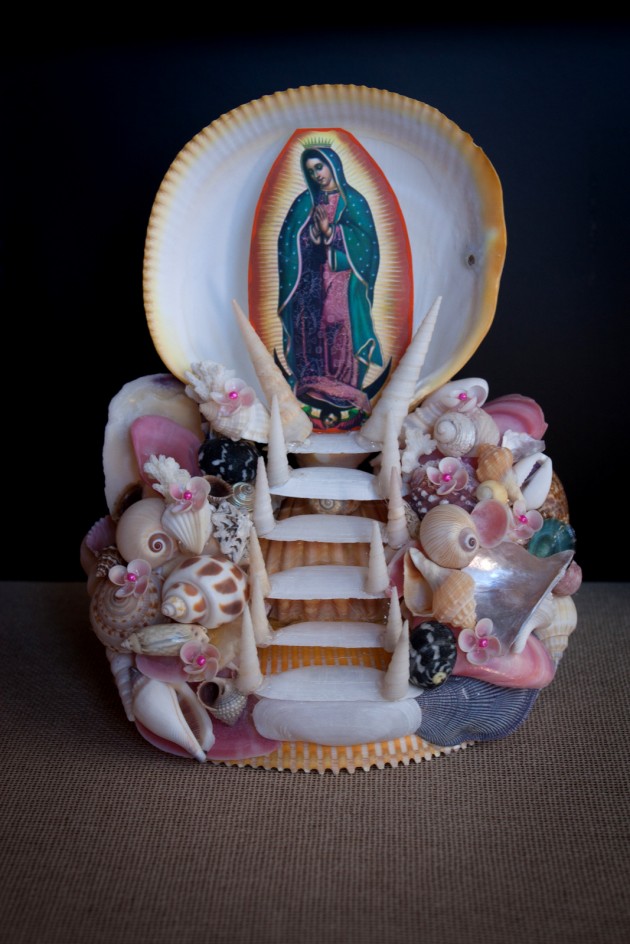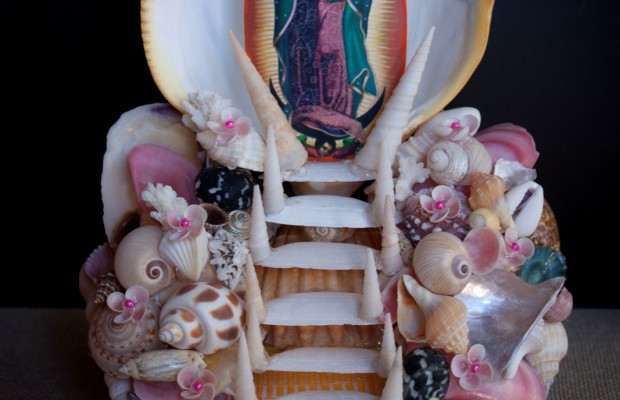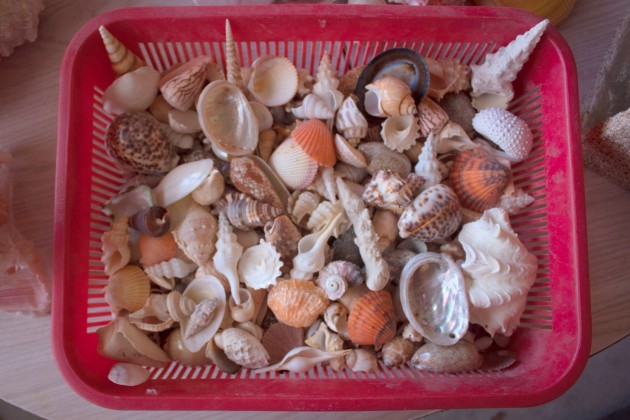By Wendy Fregozo
Her name is Jesús Ivonne, though out of affection we call her Jesu. I met her as a student in one of my candle workshops. When we met I was intimidated because she was very curious and wanted to know everything. I was afraid I wouldn’t have an answer for it all. Through her is how I met Gabriel Mungarro, who I spoke of earlier in my first Meet the Artisan article.
 When I interviewed Gabriel, I had thought of interviewing both of them, but that didn’t happen. Though they are a couple, each of them has their own artistic qualities and each deserves their own space.
When I interviewed Gabriel, I had thought of interviewing both of them, but that didn’t happen. Though they are a couple, each of them has their own artistic qualities and each deserves their own space.
Sitting together in the middle of her kitchen, a box filled with an infinite number of shells and treasures from the sea took up the center of the table. As I selected which ones to view, we began to chat.
“How did you begin creating your figures?”
“When I got married I learned along with my husband, because I don’t like to be without nothing to do. As a young girl I didn’t make figures; I didn’t like it at all. In fact I would spend my time washing the shells and groaning about it. Washing the shells is an entire process; first you cut them, separate them, and put them in soapy water so the flesh softens and they’re able to be cleaned.”
“Classifying them is another step,” she details, “Each of the shells has two sides, the right and the left – the majority of these being clam, here, you can see.”
She shows me a clam shell though honestly both sides look the same to me.
“Look, this is called “papa” potato, and I use it to make really beautiful flowers.” She grabs another shell and says, “See, this one for example, we don’t use the larger part because it’s full of polyps.”
“Do you have your own designs?” I inquire.
“Yes.”
“What figures do you most like to make?”
“How many do you make in a day?”
“One hundred,” she says unabashedly, “I could make more, but I just do a hundred.”
“Where do you sell your items?”
“On the road to La Cholla (los curios) and on the malecón. I already have my own clients and only make deliveries.”
For now, Jesu works principally in bulk though she would like to sell directly to the public.
“Do you receive orders for figures?”
“Yes.”
The delightful sound of shells being pushed together can be heard while we chat; it was a mixed box of shells.
“The busiest time is Semana Santa,” Jesu notes, “that’s when there’s more tourism.”
“What type of shells do you use?”
“All of them.”
I interrupt her, “…or at least I call them all shells.”
“Noooo!” She exclaims, “Everything has its own name. Look, this is called “pinta,” that one is “lapa”, there’s “cuquina”, “stripper”, “dove.” Look, this is a button; there’s a natural button and a chrome button. This one is dove.”
“Who named all of these?”
“I’m not sure,” she reflects, “We’ve always known their names through tradition. I struggled to learn them all. For example, my husband would tell me, ‘pass me the cuquina,’ and I would say, ‘which?’ Cuquina is a purpleish shell, like this one,” as she stirs the box.
“This is choro,” she goes on enthusiastically, “but this choro is not from here. If you check, many of these are not from here. This is called “rosa cop;” this is the tip of a shell, called caramel. These that look like they’ve already been painted, that’s how they come. They’re not very rare but they are very experience. Almost nobody works with that because it’s expensive. This,” she holds up another, “is “stripper.”
“Stripper? What does it have to do with a stripper?” I burst out.
“I don’t know,” she chuckles.
 In seemingly showing off my expertise in the area I explain, see these stripes – striped comes from the stripes on the shell and somehow over time the name was distorted because it’s striped, while a stripper is a dancer. We laugh together and she exclaims, “Wendy’s taught us something!”
In seemingly showing off my expertise in the area I explain, see these stripes – striped comes from the stripes on the shell and somehow over time the name was distorted because it’s striped, while a stripper is a dancer. We laugh together and she exclaims, “Wendy’s taught us something!”
“These are olivos… this is the tip of an erizo….”
“You know,” I interrupt her again, “I was once given a bucket of shells and this was in it and I thought they had mistakenly thrown out part of a comb, but no, they’re erizos.”
Picking up another sample I go on, “I’ve seen these since I was a little girl, what are they called?”
“Buttons, they’re like grey buttons,” she responds, “I remember when I was girl, the patio at my school was full of tiny shells like this. This is originally from here, from Puerto Peñasco. This is porcelain, pina, olivos, papas… This is a clam shell; I make flowers from these.”
Oh goodness, and here I would always just throw them away! “If someone wants to learn how to make flowers, do you teach classes or do you protect your work.”
“I teach classes,” she responds assuredly. “If someone wants to learn, I’ll teach them. God provides for all of us.”
“I don’t use starfish very much for decorating or making figures,” Jesu remarks, “they are expensive and not cost-effective to use, they don’t pay for that here. They are only for work to sell directly. The starfish is from Rosarito, from Ensenada.”
She shows me another shell, “If you look closely, this is already an old shell.” How can you tell? “By the colors. A younger (newer) shell is colorful, that’s why it’s called caramel. They look like God has painted them each by hand.”
I can see the defined stripes of blue, black, yellow, and red.
“So this means that age defines the color?”
“Yes,” she nods.
“Over time you begin to learn about all the shells. There are some shells that seem beautiful to me, but my husband says they’re ugly.”
“Like which?”
“Like these. My husband only uses them for monkeys, and I like to use them for flowers. He never uses them because he says they’re cheap, but they’re beautiful I tell him, because they’re from here.”
“Have you thought about looking to market in other cities?”
“Leave here? Actually, we’ve gone to sell in Hermosillo on different occasions and I’ve gone to Cananea to sell.”
 “You never get tired of shells,” Jesu reflects as she continues classifying those in the box, “When you can’t figure out one way, you figure out another.”
“You never get tired of shells,” Jesu reflects as she continues classifying those in the box, “When you can’t figure out one way, you figure out another.”
“Why are there more figures of animals, is it because it’s a tradition in Puerto Peñasco or why?”
“It’s what’s normally done but we make a variety of figures from drunkards, fishermen, musicians, and mermaids; an infinity of designs as well as mirrors, napkin holders, curtains, whatever you ask for. I make bridal ropes and bouquets; I decorate the bridal glasses, all the party elements, and all with marine life themes.”
Inquisitively I remark, “I remember a comment from someone who said it wasn’t good to use shells because of its ecologic impact, as the shells are home to some animals.”
“These are purely dead shells,” she responds quite certainly. “When the shells come out of the sea it is like waste, it doesn’t affect nature at all. All of this that we go and collect is debris, lifeless, sea waste.”
“So it’s like a type of recycling?”
“Yes, in fact there are a lot of shells we collect from the dump. Processing plants go and dump shells there; we go and collect them, clean them, and then can work with them. It’s always full of flies,” she visibly complains.
“Do you protect yourself when you go to the dump?”
“Yes, we use masks.”
“So you really love your work,” I conclude.
“Oh yes,” she reiterates. “People think this is something simple, that’s it’s just about going to the beach and gathering shells and putting them together, but no it’s an entire process.”
I could have spent the entire day speaking with her. I had numerous questions as it’s an interesting topic and chatting with Jesu is a pleasure. She’s such an active person, always anxious to learn, and makes you laugh with her stories. She is simply lovable. Personally she has taught me one should not only work for the different seasons, but rather throughout the year. She is a bank of knowledge; in addition to being an artisan she makes ice-cream cakes, paints on cloth, is a housewife and never lets her doubts go unanswered. She is always ready and eager to learn.
Jesus Ivonne De la Torre Aldaco
Home phone 388 1074
Cell 638 107 1426

